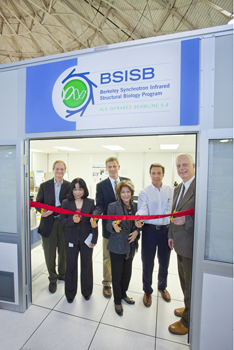

 From l-r, Paul Alivisatos, Hoi-Ying Holman, Bob Schoenlein, Mina Bissell, Ernie Majer, and Roland Hirsch (DOE)
From l-r, Paul Alivisatos, Hoi-Ying Holman, Bob Schoenlein, Mina Bissell, Ernie Majer, and Roland Hirsch (DOE)
“Life at the top is nice,” remarked Paul Alivisatos, as Berkeley Lab’s director kicked off the ceremonies to inaugurate beamline 5.4, the palindromic BSISB – Berkeley Synchrotron Infrared Structural Biology program – located on the roof blocks of the Advanced Light Source’s linac and beamline test facility. With a nod to Jim Krupnick, the Lab’s associate director for operations, Alivisatos joked that the unusual location was the “first implementation of the Lab’s new space planning initiative.”
In fact the unusually spacious experimental area, as Alivisatos quickly noted, was made possible by the fact that long-wavelength infrared light, unlike the soft x-rays for which the ALS is optimized, can be steered and focused by ordinary optical mirrors, making the sharp vertical turn to the roof practical. The extra space is necessary, said Michael Martin, one of the ALS infrared pioneers, so that live biological specimens can be prepared right next to the instruments; what’s more, as the ribbon-cutting event’s co-emcee Peter Nico of Earth Sciences pointed out, the extra laboratory space makes it possible for the same sample to be viewed with a variety of imaging and spectroscopic techniques.
A great advantage of synchrotron infrared spectromicroscopy is that it doesn’t kill its living subjects, explained BSISB director Hoi-Ying Holman, as she told the audience about her introduction to the ALS and the evolution of the new facility. “In 1997 I was looking for a way to study the chemistry of microbes on rock surfaces in real time and noninvasively. On my first visit to the ALS I ran into Wayne McKinney, who told me the good news and the bad news: there was an infrared beamline, but all the equipment was still in the boxes. So I became its first user by helping tune beamline 1.4 while Wayne and Michael were putting it together.”
The new beamline 5.4 facility boasts numerous tools for synchrotron radiation-Fourier transform infrared spectroscopy (SR-FTIR) for doing real-time biochemistry in living cells, including cells in aqueous environments – which makes it an ideal instrument for both life sciences and environmental sciences. A cross-section of users inside and outside Berkeley Lab are already lining up; the kind of interest the BSISB has generated was evident from Berkeley Lab scientists spotted at the ceremony, who included Robert Schoenlein of the ALS; Ernie Majer, Terry Hazen, Susan Hubbard, and Christer Jansson of Earth Sciences; Mina Bissell and Eleanor Blakely of Life Sciences; Paul Adams and Jamie Cate of Physical Biosciences; and many others.
Beamline 5.4 and the Berkeley Synchrotron Infrared Structural Biology program are supported by the Office of Biological and Environmental Research, Office of Science, U.S. Department of Energy. For more about the technical capabilities of SR-FITR at the BSISB, go here.
Today at Berkeley Lab is produced by Public Affairs' Communications Department